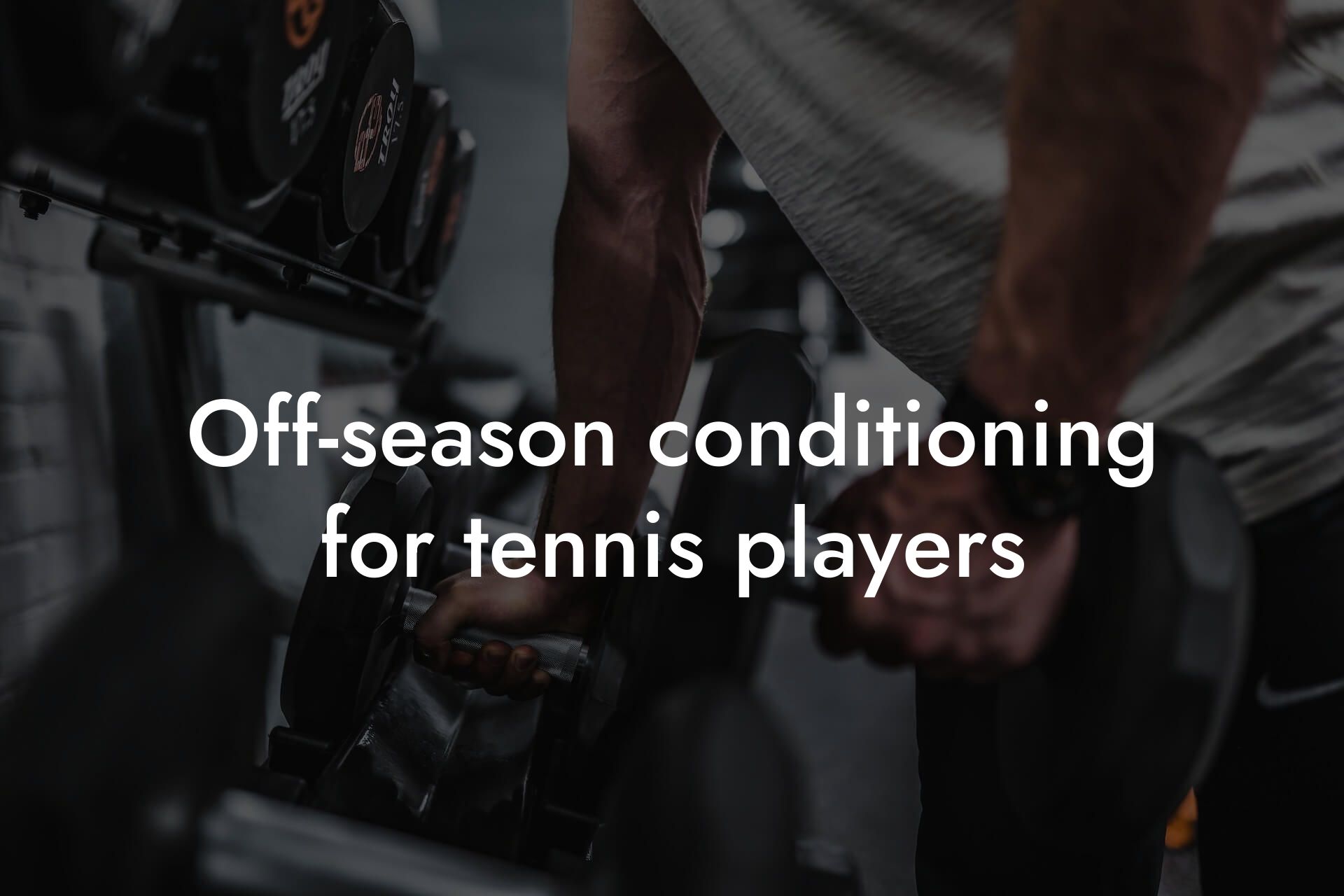As a tennis player, you understand the importance of being in top physical condition to perform at your best on the court. One key aspect of achieving optimal tennis performance is maintaining a healthy body fat percentage. Excess body fat can hinder your agility, speed, and endurance, making it more challenging to compete at a high level. In this article, we'll explore the importance of reducing body fat for tennis players and provide you with a comprehensive guide on how to achieve your goals.
Table of Contents
Why Body Fat Matters in Tennis
Body fat plays a significant role in tennis performance. Carrying excess body fat can increase your risk of injury, reduce your power and speed, and decrease your endurance. Tennis players with higher body fat percentages often struggle with quick movements, agility, and sustained effort over an extended period. Furthermore, excess body fat can also affect your mental performance, leading to decreased confidence and focus.
The Ideal Body Fat Percentage for Tennis Players
The ideal body fat percentage for tennis players varies depending on factors such as age, sex, and playing level. Generally, male tennis players should aim for a body fat percentage between 6-12%, while female tennis players should aim for 16-23%. However, these are general guidelines, and the optimal body fat percentage for you will depend on your individual needs and goals.
How to Measure Body Fat Percentage
There are several ways to measure body fat percentage, including skinfold measurements, bioelectrical impedance analysis (BIA), and dual-energy X-ray absorptiometry (DEXA). DEXA scans, like those offered by Tano Performance Group, provide a highly accurate and comprehensive assessment of body composition, including body fat percentage, lean mass, and bone density.
Nutrition Strategies for Reducing Body Fat
A well-planned nutrition strategy is essential for reducing body fat and improving tennis performance. Focus on consuming a balanced diet that includes:
- Lean protein sources: chicken, fish, turkey, and plant-based options like beans and lentils
- Complex carbohydrates: whole grains, fruits, and vegetables
- Healthy fats: nuts, seeds, avocado, and olive oil
Aim to create a calorie deficit by eating fewer calories than your body burns. Aim for a daily calorie deficit of 500-1000 calories to promote weight loss while preserving lean mass. Additionally, stay hydrated by drinking plenty of water and limiting sugary drinks.
Training Strategies for Reducing Body Fat
A well-structured training program is crucial for reducing body fat and improving tennis performance. Incorporate a combination of cardio, strength, and high-intensity interval training (HIIT) into your routine. Cardio exercises like running, cycling, or swimming can help you burn calories and improve cardiovascular fitness. Strength training exercises like squats, lunges, and deadlifts can help you build lean mass and increase your metabolism. HIIT workouts, which involve short bursts of intense exercise, can help you burn fat and improve speed and agility.
Sample Workout Routine for Tennis Players
Here's a sample workout routine that you can incorporate into your training program:
- Monday: Cardio day (30-45 minutes of steady-state cardio)
- Tuesday: Strength training (lower body focus)
- Wednesday: Rest day
- Thursday: HIIT workout (20-30 minutes)
- Friday: Strength training (upper body focus)
- Saturday: Rest day
- Sunday: Cardio day (30-45 minutes of steady-state cardio)
Progress Tracking and Adjustments
Regularly tracking your progress is essential for reducing body fat and improving tennis performance. Take progress photos, measurements, and track your body fat percentage using a DEXA scan or other measurement tools. Adjust your nutrition and training strategies as needed to ensure you're meeting your goals.
Reducing body fat is a crucial aspect of improving tennis performance. By understanding the importance of body fat, measuring your body fat percentage, and implementing effective nutrition and training strategies, you can achieve your goals and take your tennis game to the next level. Remember to regularly track your progress and make adjustments as needed. With dedication and hard work, you can optimize your body composition and become a more agile, powerful, and confident tennis player.
Frequently Asked Questions
What is the ideal body fat percentage for tennis players?
For tennis players, the ideal body fat percentage varies depending on factors such as age, gender, and position on the court. Generally, a body fat percentage of 6-13% for men and 16-23% for women is considered optimal for tennis performance. However, it's essential to note that a lower body fat percentage doesn't always translate to better performance. A healthy body fat percentage range allows for adequate energy storage, muscle function, and overall athletic performance.
How does excess body fat affect tennis performance?
Excess body fat can negatively impact tennis performance in several ways. It can increase the risk of injuries, reduce speed and agility, and decrease endurance. Additionally, excess body fat can lead to increased fatigue, slower reaction times, and decreased power and strength. Furthermore, carrying excess body fat can also affect a player's mental performance, leading to decreased confidence and focus.
What are the benefits of reducing body fat for tennis players?
Reducing body fat can have numerous benefits for tennis players. It can improve speed, agility, and endurance, allowing players to cover the court more efficiently. It can also increase power and strength, enabling players to hit more effective shots. Furthermore, reducing body fat can improve mental performance, boost confidence, and enhance overall athletic performance.
How can I measure my body fat percentage?
There are several ways to measure body fat percentage, including skinfold measurements, bioelectrical impedance analysis (BIA), dual-energy X-ray absorptiometry (DXA), and hydrostatic weighing. Skinfold measurements involve pinching the skin at specific points on the body to measure the thickness of the subcutaneous fat layer. BIA uses a device to send an electrical current through the body to estimate body fat percentage. DXA uses X-rays to measure bone density and body composition. Hydrostatic weighing involves measuring body weight while submerged in water to estimate body density and body fat percentage.
What is the best way to reduce body fat for tennis players?
The most effective way to reduce body fat for tennis players is through a combination of proper nutrition, regular exercise, and sufficient rest and recovery. A balanced diet that is high in protein, moderate in complex carbohydrates, and low in fat can help support weight loss and improve body composition. Regular cardiovascular exercise, such as jogging or cycling, can also help burn calories and reduce body fat. Additionally, incorporating strength training exercises that target the muscles used in tennis, such as the legs and core, can help improve overall athletic performance.
How much body fat can I expect to lose in a week?
A safe and sustainable rate of body fat loss is 0.5-1% per week. This translates to a weight loss of 0.5-1 kg per week for a 70 kg person. Losing weight too quickly is not healthy and is unlikely to be sustainable in the long term. It's essential to focus on making lifestyle changes that promote gradual weight loss and improved body composition.
What are the best exercises for reducing body fat for tennis players?
The best exercises for reducing body fat for tennis players are those that target the muscles used in tennis, such as the legs, core, and glutes. Examples of effective exercises include squats, lunges, deadlifts, and leg press. Additionally, exercises that improve cardiovascular fitness, such as jogging, cycling, and swimming, can also help burn calories and reduce body fat.
How can I incorporate strength training into my tennis training?
Incorporating strength training into your tennis training can be done by dedicating 2-3 days per week to strength training exercises. Focus on exercises that target the muscles used in tennis, such as the legs, core, and glutes. Aim to do 3-4 sets of 8-12 repetitions for each exercise. It's essential to start with lighter weights and gradually increase the intensity as you build strength and endurance.
What is the role of nutrition in reducing body fat for tennis players?
Nutrition plays a critical role in reducing body fat for tennis players. A balanced diet that is high in protein, moderate in complex carbohydrates, and low in fat can help support weight loss and improve body composition. Focus on consuming whole, unprocessed foods, such as lean meats, fish, fruits, and vegetables. Avoid sugary drinks and foods high in added sugars, salt, and unhealthy fats.
How can I stay motivated to reduce body fat?
Staying motivated to reduce body fat requires setting realistic goals, tracking progress, and celebrating small victories. Share your goals with a friend or family member and ask for their support. Take progress photos, measurements, and track your body fat percentage regularly. Celebrate small victories, such as increasing your endurance or hitting a personal best shot, to stay motivated and focused.
What are the risks of rapid weight loss for tennis players?
Rapid weight loss can have several risks for tennis players, including decreased muscle mass, reduced endurance, and increased risk of injuries. Additionally, rapid weight loss can lead to nutrient deficiencies, fatigue, and decreased mental performance. It's essential to focus on gradual weight loss and improved body composition to minimize these risks.
How can I maintain my muscle mass while reducing body fat?
Maintaining muscle mass while reducing body fat requires a balanced diet that is high in protein and moderate in complex carbohydrates. Aim to consume 1.6-2.2 grams of protein per kilogram of body weight daily. Additionally, incorporate strength training exercises that target the muscles used in tennis, such as the legs, core, and glutes, to help maintain muscle mass.
What is the role of hydration in reducing body fat for tennis players?
Hydration plays a critical role in reducing body fat for tennis players. Adequate hydration can help improve athletic performance, increase endurance, and support weight loss. Aim to drink at least 8-10 glasses of water per day, and make sure to drink water before, during, and after exercise.
How can I reduce body fat without sacrificing muscle mass?
Reducing body fat without sacrificing muscle mass requires a balanced diet that is high in protein and moderate in complex carbohydrates. Aim to consume 1.6-2.2 grams of protein per kilogram of body weight daily. Additionally, incorporate strength training exercises that target the muscles used in tennis, such as the legs, core, and glutes, to help maintain muscle mass. Focus on gradual weight loss and improved body composition to minimize muscle loss.
What are the benefits of high-intensity interval training (HIIT) for tennis players?
HIIT can be an effective way to improve cardiovascular fitness, increase speed and agility, and reduce body fat for tennis players. HIIT involves short bursts of high-intensity exercise followed by brief periods of rest. This type of training can be adapted to tennis-specific exercises, such as sprints and shuttle runs, to improve overall athletic performance.
How can I incorporate HIIT into my tennis training?
Incorporating HIIT into your tennis training can be done by dedicating 2-3 days per week to HIIT exercises. Start with short bursts of high-intensity exercise, such as 20-30 seconds, followed by 1-2 minutes of rest. Gradually increase the duration and intensity of the exercise as you build endurance. Examples of HIIT exercises for tennis players include sprints, shuttle runs, and burpees.
What are the risks of overtraining for tennis players?
Overtraining can have several risks for tennis players, including increased risk of injuries, decreased endurance, and decreased mental performance. Additionally, overtraining can lead to fatigue, decreased motivation, and burnout. It's essential to balance training with rest and recovery to minimize these risks.
How can I avoid overtraining and maintain optimal performance?
Avoiding overtraining and maintaining optimal performance requires balancing training with rest and recovery. Make sure to incorporate rest days into your training schedule, and prioritize sleep and nutrition to support recovery. Additionally, listen to your body and take regular breaks to avoid fatigue and prevent injuries.
What is the role of sleep in reducing body fat for tennis players?
Sleep plays a critical role in reducing body fat for tennis players. Adequate sleep can help regulate hormones that control hunger and fullness, support weight loss, and improve overall athletic performance. Aim to get 7-9 hours of sleep per night to support recovery and weight loss.
How can I improve my overall athletic performance?
Improving overall athletic performance requires a combination of proper nutrition, regular exercise, and sufficient rest and recovery. Focus on making lifestyle changes that promote gradual weight loss and improved body composition. Incorporate strength training exercises that target the muscles used in tennis, and prioritize cardiovascular fitness and agility training. Additionally, make sure to get adequate sleep and prioritize nutrition to support recovery and overall athletic performance.
What are the benefits of working with a personal trainer or coach for tennis players?
Working with a personal trainer or coach can be beneficial for tennis players as they can provide personalized guidance and support to help improve overall athletic performance. A personal trainer or coach can help develop a customized training program that targets specific areas of improvement, provide feedback on technique and form, and offer support and motivation to stay on track.
How can I stay accountable and motivated to reach my fitness goals?
Staying accountable and motivated to reach your fitness goals requires setting realistic goals, tracking progress, and celebrating small victories. Share your goals with a friend or family member and ask for their support. Take progress photos, measurements, and track your body fat percentage regularly. Celebrate small victories, such as increasing your endurance or hitting a personal best shot, to stay motivated and focused.
Here are some related articles you might love...
- Strength training programs for tennis athletes
- The importance of DEXA scans for tennis players
- Off-season conditioning for tennis players
- How to maintain endurance during long tennis matches
- The role of bone density in preventing tennis injuries
- Improving core strength for better tennis strokes
- How body composition impacts tennis agility and speed
- Nutrition strategies for sustained energy during tennis matches
- Recovery techniques for tennis professionals
Zak Faulkner
Zak Faulkner is a leading authority in the realm of physical health and body composition analysis, with over 15 years of experience helping professionals optimise their fitness and well-being. As one the experts behind Tano Performance Group, Zak has dedicated his career to providing in-depth, science-backed insights that empower clients to elevate their physical performance and overall health.
With extensive knowledge of DEXA technology, Zak specializes in delivering comprehensive body assessments that offer precise data on body fat, muscle mass, bone density, and overall physique. His expertise enables individuals to make informed decisions and achieve their fitness goals with accuracy and confidence. Zak’s approach is rooted in a deep understanding of human physiology, combined with a passion for helping clients unlock their full potential through personalised strategies.
Over the years, Zak has earned a reputation for his commitment to excellence, precision, and client-focused service. His guidance is trusted by top professionals who demand the best when it comes to their health. Whether advising on fitness programs, nutritional strategies, or long-term wellness plans, Zak Faulkner’s insights are a valuable resource for anyone serious about taking their health and fitness to the next level.
At Tano Performance Group, Zak continues to lead our Content Team revolutionising how professionals approach their physical health, offering unparalleled expertise that drives real results.




